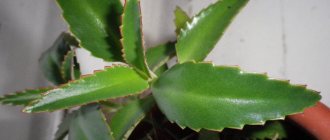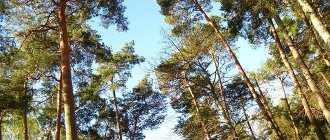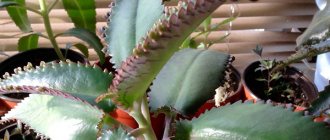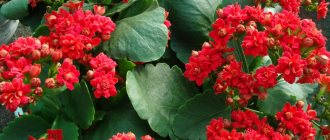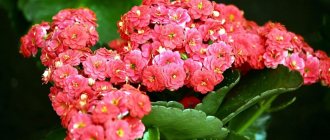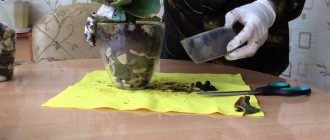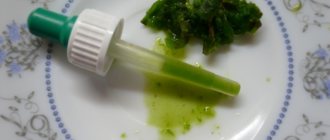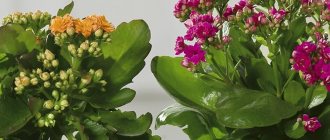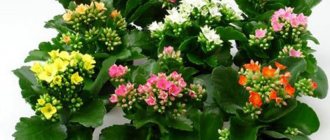Care
Kalanchoe Degremona care at home. Degremona is an unpretentious succulent that does not cause any special problems during care and flowering.
With proper care it blooms well and abundantly.
But you should be careful , as the flower releases toxic substances that can cause migraines. Children should not be allowed near the plant.
Temperature and humidity
Degremona comes from the subtropics, so it is very important to create the right temperature conditions for it.
In summer, the ideal temperature for a flower is 27⁰С, but it is most important to observe the temperature regime in winter, since it is in winter that buds are laid and flowering occurs.
In winter, the room temperature should not be less than 15⁰C, but the plant will not withstand high temperatures. You should not place a pot with a succulent near heating appliances in winter, as this will prevent proper growth.
Air humidity should be moderate; Kalanchoe does not require high humidity in the room.
Lighting
In winter, it is best to place the plant on southern or southeastern windows, since Degremona is a light-loving plant .
But in summer you should create partial shade, otherwise the leaves may turn red due to sunburn.
The optimal time to spend in the sun in the summer is about 9 hours. This will have a good effect on flowering in the future.
Watering
Kalanchoe Degremona officinalis tolerates dry conditions quite well, and since Degremona is a succulent , watering the plant should be kept to a minimum. In summer, spraying and rare watering, always on dry soil.
If you constantly flood Degremona, the roots will begin to rot and the plant will die.
The soil
The soil for Degremona should consist of several layers. The first layer is peat, then deciduous and turf soil, and on top is a piece of coarse sand or perlite.
Good drainage is important; it is placed at the bottom of the pot and sprinkled on top to prevent excess moisture. The pot should be heavy and stable, as the plant becomes heavier with age.
Top dressing
In the summer, you need to fertilize Kalanchoe every 2-3 weeks using fertilizers for cacti.
In winter, fertilizers are needed for flowering plants; 1-2 feedings are enough.
You can use complex fertilizers.
Transfer
Flower transplantation is carried out in early spring. In addition, it is advisable to replant the succulent immediately after purchase so that the plant can reproduce better.
You can add charcoal or brick chips to the soil mixture. Kalanchoe is replanted once a year as it grows.
Botanical portrait
The appearance of the succulent differs significantly from its relative in the Crassulaceae family. Kalanchoe pinnata is an evergreen plant with a height of 60 to 120 cm with a short branched root system and a strong, erect stem that becomes woody in the lower part. The leaf blades are thick and fleshy, ovoid or oval in shape, their edges are blunt-toothed. The lower leaves are simple, and those that develop later, closer to the apex, are often complex, consisting of 5–7 lobes.
Unlike Kalanchoe Degremona, the plant's brood buds are formed from the teeth of leaves separated from the mother plant and placed in water or moist soil. The flowers are tubular, drooping in a dense paniculate inflorescence; their color combines whitish-light green-pink shades. The fruits are capsules 10–14 mm long with many small – about 1.2 mm – oval seeds.
Reproduction
There are several ways to breed Degremona .
The first is by shoots from the tops of the leaves. In spring, ready-made shoots with roots disappear on their own. They need to be selected and planted in separate pots with peat and sand. Cover the container with film and make small holes for ventilation.
Place the sprouts After the shoots take root and the first leaves appear, you should remove the film and pinch the crown. Spray the soil periodically.
The second method of propagation is by seeds. They are sown at the end of winter in soil made of sand and leaf soil. Keep the temperature around 20-22⁰С.
In the second week, the seeds begin to germinate; they should be picked and then the pot should be exposed to sunlight.
Find out what other types of Kalanchoe there are: Rosalina, Blossfelda, Pinnate, Mangina.
Types of Kalanchoe
Kalanchoe can look so different that it is difficult to classify two flowerpots as the same genus. And all because there are about 200 varieties in the world. True, only a few of them are usually grown at home.
Kalanchoe Degremona
The variety is not decorative at all, but it is what they first of all mean when they talk about medicinal Kalanchoe. The succulent reproduces easily, because its “babies” grow directly on the leaves, and in large quantities.
Kalanchoe Blossfeld
The compact ornamental bush blooms with bright umbrella-inflorescences. This same variety includes the very popular Kalandiva series with voluminous double flowers.
Kalanchoe dissected
Spectacular long shoots are densely covered with narrow leaves of dissected type. Due to its characteristic appearance in everyday life, such Kalanchoe is called “deer horns”.
Kalanchoe pinnate
Another medicinal variety is propagated in the same way by “babies” on the leaves. The pattern of veins on the elastic leaf blades resembles feathers, which is how the name came about.
Kalanchoe Mangina
This is a decorative ampelous variety that blooms with scarlet bells. And it also reproduces by “babies”, because it belongs to the so-called bryophyllums.
Kalanchoe tubiflora
And again another bryophyllum in the rows of Kalanchoe, but this time it can be called decorative. And all because its plates are intricately wrapped into tubes.
Medicinal properties
Kalanchoe Degremona medicinal properties . The medicinal properties of Kalanchoe viviparous juice were discovered in the second half of the 20th century. Currently, the juice and pulp of the leaves are used on a large scale to produce medicines, creams and ointments. In addition, the plant can serve as a home doctor.
The juice of the flower is used to treat runny nose, flu and headaches.
Degremona is an unpretentious succulent , which, with proper care, will delight you with its appearance for a long time, and will also become a real assistant for the treatment of many diseases and ailments.
How to get Kalanchoe Degremona to bloom?
In the wild, Kalanchoe Degremona blooms regularly. In indoor conditions, flowering occurs extremely rarely. Experienced flower growers who have managed to achieve flowering say that this is quite difficult to do: it is necessary to limit watering for a month, completely remove fertilizing, do not replant the plant and keep it in a shaded place. Then it is necessary to gradually resume the normal life of the flower. The combination of these factors can ultimately trigger flowering.
If you want to become the happy owner of an unpretentious medicinal plant, you should take a closer look at Kalanchoe Degremon. This is a real green healer on your windowsill, always at hand and ready to share its healing properties with you at any time.
Diseases and pests
Kalanchoe is harmed by excessive sun rays, excess moisture and excessive feeding. It is necessary to monitor the condition of the root system so that it does not rot.
If this happens, you need to remove the affected areas and replant the succulent.
Of the parasites, the most dangerous is the scale insect, which causes a gray coating and fungus to appear on the leaves and stems.
Stains are removed with a brush, then the leaves are wiped with alcohol.
Mealybugs leave a white coating on the leaves. They are also removed with an alcohol solution.
When aphids appear, yellowing of the leaves is observed; the insects themselves are located at the bottom of the leaf. The plant is treated with laundry soap.
In addition, there are many pest control products that can be found in specialty stores.
Kalanchoe tubiflora
Like Kalanchoe Degremona, the Kalanchoe tubiflora shown in the photo forms a mass of babies on the leaves. This species also lives in the dry semi-deserts of Madagascar and forms strong bushes up to 70–80 cm high. Otherwise, it is difficult to compare these closest relatives.
When you first look at Kalanchoe tubiflora, what catches your attention are the narrow, up to 13 cm long leaves of a grayish-green hue. Brown spots are clearly visible on the light background color, giving the plant an even more unusual appearance. Flowers appearing on tall peduncles are elongated and burgundy-red in color.
Botanical description and composition of Kalanchoe pinnate
Kalanchoe belongs to the Tolstyankov family, its homeland is the island of Madagascar.
In nature, the bush grows on slopes in depleted rocky soil and reaches a length of 2 meters. In an apartment, its height is much smaller and depends on the living conditions. The stem is hollow, fleshy, and as it grows it becomes woody at the base. The leaves are bright green, oval-shaped, located opposite each other. Along the edges there are teeth, between which children grow, with the help of which Kalanchoe reproduces. A plant that is more than 2 years old often blooms. This happens in winter, when daylight hours become shorter. The bush forms an arrow growing upward and extending beyond the cap of leaves. Hanging flowers appear on it - light pink buds about 4 cm in size. Later, fruits are formed, which are small boxes with seeds.
Several hundred species of Kalanchoe are found in natural conditions. It grows in Africa, on the island of Madagascar, America, Australia and Asian countries. However, its varieties can differ significantly from each other. In natural conditions, you can find Kalanchoe up to two meters high, similar to a small tree.
Kalanchoe in nature
Varieties suitable for growing indoors are divided into two groups:
- decorative flowering;
- decorative deciduous.
Blooming Kalanchoe is often used to decorate office spaces. Its small compact bush with glossy dark green leaves and small flowers collected in panicle-shaped inflorescences pleases the eye all winter until spring. The flowers vary in shades - from white, cream to bright red.
Among the decorative deciduous species there are plants with different shapes of leaves, colored tips
Correct and timely pruning and pinching allows you to get a plant that attracts attention with its shape and shiny leaves.
Kalanchoe pinnate is a species that belongs to the Crassulaceae family. This is a succulent characterized by fleshy stems and succulent leaves. A single large, erect stem is formed that can reach more than a meter in height. It often produces many side shoots with leaves exactly opposite each other.
At the same time, the petioles are distinguished by a beet-red color. Leaves with characteristic serrated edges, medium in size (15-17 cm in length and up to 9-12 cm in width). The inflorescences are formed in the form of panicles, the pedicels are very small. Flowers and fruits are also small, so they have no decorative value.
In its natural habitat, Kalanchoe is distributed in the warm tropical regions of America, Africa and the tropical islands of Asia. The plant has a wide species diversity - represented by more than 200 species. They are conditionally divided into 2 groups:
- medicinal;
- decorative.
According to its chemical composition, the plant juice contains quite a lot of organic substances and microelements useful for the body:
- Various biologically active substances.
- Flavonoids.
- Numerous organic acids.
- Tannins.
- Polysaccharides.
- Microelements.
Characteristics of the Kalanchoe flower and species diversity
Kalanchoe is a perennial succulent. The genus Kalanchoe is divided into herbaceous plants, vines and shrubs. Some species are epiphytes.
The leaves are juicy and fleshy. They can fit tightly to the stem or be attached using petioles. Some species have an edge on the leaf blades. The color of the leaves varies depending on the type of plant. In most cases, it is monochromatic, represented by different shades of green. There are also variegated Kalanchoes with purple or red inserts on a green background or marbled plates.
There are beautiful flowering species. You can appreciate the charming Kalanchoe flowers in the photo below.
Flowers are collected in multi-flowered umbrella-shaped inflorescences. Most often, the inflorescences are located at the top. Less often - on the sides of the plant. The color of the flowers depends on the species: white, yellow, purple, shades of red. As a rule, flowering occurs in the autumn-winter period, but some species bloom in the spring.
The following types of plants are distinguished:
- Beharsky is a herbaceous plant that is distinguished by bare stems that are not prone to branching. Falling leaves leave behind scars. The leaf blades have a waxy coating and edge. The leaf shape is wedge-shaped. Inflorescences are apical. The flowers are small. The yellow petals also have a edge.
- Blossfelda is a low shrub with smooth ovoid leaves. The color of the leaves is a combination of red and green. A beautiful flowering species. Blooms profusely. Depending on the variety, the petals can be red, white, purple, or yellow.
- Benta (Bristlenifolia) is a powerful subshrub with thick rounded leaves. Blooms in spring. The flowers are large and white.
- Felt – popularly known as Cat Ears. Shrub with densely pubescent erect stems. It has sessile oblong leaves. It blooms with small dark red flowers. The inflorescences are also pubescent.
- Degremona is a herbaceous plant with oblong, fleshy leaves. The leaf blades are tucked along the central vein and have a pointed edge. The species is capable of forming babies on the edges of leaf blades.
- Marble (large-flowered, Somali) - half-meter shrub with unusual leaves. The leaves are obovate in shape with notches along the edges. They bloom green, but over time they acquire a bluish tint; lilac spots appear on the outside of the plates. Representatives of the species bloom with small white flowers.
- Large-flowered - a subshrub with sessile lobed-toothed leaves. Initially they are green, but in the sun they acquire a reddish tint. It blooms in May with large red or yellow flowers.
- Mangina is a shrub grown as an hanging plant. Representatives of the species are distinguished by drooping inflorescences with a large number of pink-red flowers. The flowering period begins in spring.
- Paniculata is a herbaceous Kalanchoe with a dense basal rosette of leaves. On green, obovate-shaped leaves, a purple border appears over time. Flowering occurs in April. The inflorescences consist of small yellow flowers.
- Flame (Fire-red, Bluish) is a herbaceous, beautifully flowering plant. Grows up to 30 cm. The leaves are dark green, obovate. The flowers are large and bright red.
- Pinnate - distinguished by different shapes of leaves on one bush. The lower ones are ovoid, the upper ones have a pinnately dissected shape. Blooms with drooping inflorescences. The color of the petals is expressed in shades of red. This species is capable of producing children.
- Tubular-flowered (Tube-flowered) is a subshrub with numerous narrow leaves on which a large number of children are located. Their color is green with a grayish tint. Has many hybrids. The color of the petals is varied.
- Dissected (Lobed) – popularly called Deer Horns. Herbaceous species with succulent fleshy shoots that tend to droop. The leaf blades are fleshy, deeply dissected. There is a waxy coating on the salad surface of the leaves. Blooms profusely. Flower color is yellow-orange.
